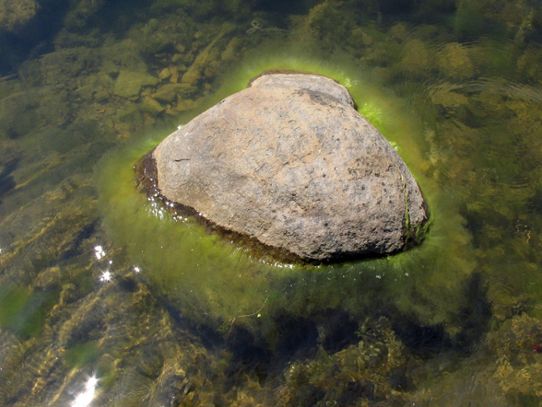
These phytoplankton form the bottom of the food chain in the sea and changes in the biomass and species distribution affect the entire marine ecosystem. Over-fertilisation of the sea has led to increased algal growth which in turn causes for example reduced visibility, an increase in dead zones (low oxygen) and more frequent incidents of harmful algal blooms.
SMHI carries out regular water sampling from research vessels followed by microscope analyses as well as measurements with automatic instruments. Satellite pictures are also used to estimate the spread of the algal blooms. The amount of chlorophyll in the water is often used as a measure of the amount of algae – the biomass of the phytoplankton.
The algal blooms are a normal occurrence and are mostly completely safe. An example is the bloom of Emiliania huxleyi in the Skagerrak in June 2004. It could be easily observed as a turquoise colour in the water, and also from satellite. The algae have a diameter of about 1/100 mm.
Many different species
Algae were among the first species to form on the planet, and there is a huge variety of species – many thousands – that are divided into a large number of groups.
Diatoms have a cell wall of silica, and are often linked into chains. The growth period is mainly early spring and late autumn.
Dinoflagellates have two flagella (“tails”) which enable them to move. This ability to swim is used a lot and the cells gather near the surface during the day and at a lower depth during the night. About 25 of the 1000 species can form toxins.
Cyanobacteria (“blue-green algae”) are actually bacteria, not algae, and are mainly found in freshwater and tropical seas. They are also very common in the Baltic, where several species bloom regularly. Some of these have the ability to form toxins.
Algal blooms in the Baltic, the Skagerrak and the Kattegat
Cyanobacteria like the brackish water of the Baltic and bloom during the summer. Some of the cyanobacteria produce toxins that can be poisonous to pets and humans.
Some algal blooms in the Skagerrak and Kattegat have affected fish, in particular cultivated salmon, and others have affected the entire ecosystem. In 1988 the little algae Chrysochromulina polylepis became known as the “murder algae”.
Other algae produce toxins that are concentrated by mussels, whose food consists almost entirely of plankton. Mussels that have consumed these algae can be life-threatening if eaten, which is why it is so important to monitor these toxin-producing phytoplankton.
New species are sometimes found, which are thought to have been introduced via ballast water from ships arriving from other parts of the world. Long-term monitoring and research around the origins of the blooms is carried out at SMHI in cooperation with other countries. In addition, models are being developed to help predict the algal blooms and increase our understanding of the connection between, physics, chemistry and biology in the sea.